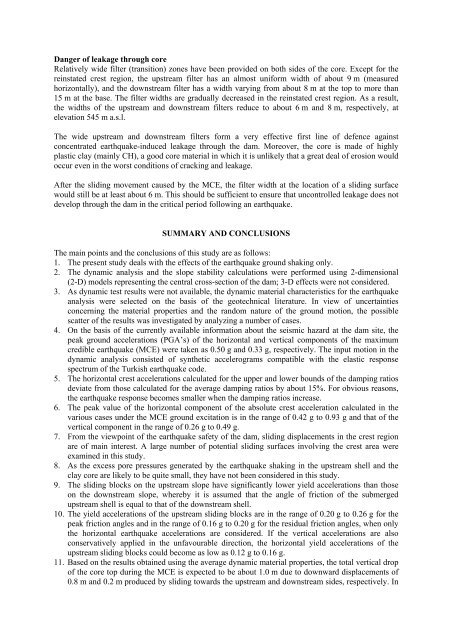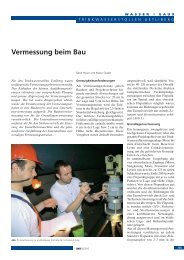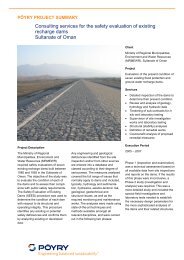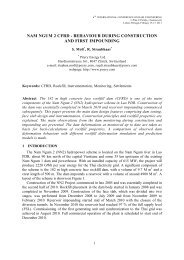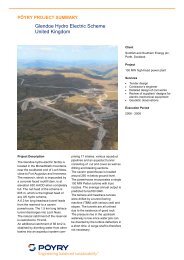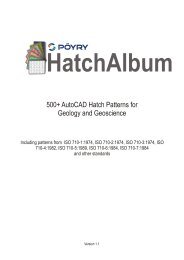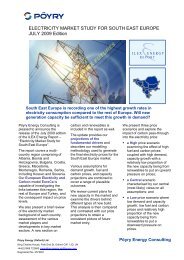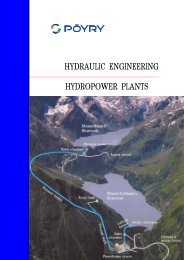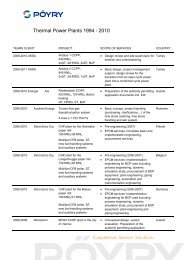EARTHQUAKE SAFETY EVALUATION OF ATATURK DAM
EARTHQUAKE SAFETY EVALUATION OF ATATURK DAM
EARTHQUAKE SAFETY EVALUATION OF ATATURK DAM
You also want an ePaper? Increase the reach of your titles
YUMPU automatically turns print PDFs into web optimized ePapers that Google loves.
Danger of leakage through core<br />
Relatively wide filter (transition) zones have been provided on both sides of the core. Except for the<br />
reinstated crest region, the upstream filter has an almost uniform width of about 9 m (measured<br />
horizontally), and the downstream filter has a width varying from about 8 m at the top to more than<br />
15 m at the base. The filter widths are gradually decreased in the reinstated crest region. As a result,<br />
the widths of the upstream and downstream filters reduce to about 6 m and 8 m, respectively, at<br />
elevation 545 m a.s.l.<br />
The wide upstream and downstream filters form a very effective first line of defence against<br />
concentrated earthquake-induced leakage through the dam. Moreover, the core is made of highly<br />
plastic clay (mainly CH), a good core material in which it is unlikely that a great deal of erosion would<br />
occur even in the worst conditions of cracking and leakage.<br />
After the sliding movement caused by the MCE, the filter width at the location of a sliding surface<br />
would still be at least about 6 m. This should be sufficient to ensure that uncontrolled leakage does not<br />
develop through the dam in the critical period following an earthquake.<br />
SUMMARY AND CONCLUSIONS<br />
The main points and the conclusions of this study are as follows:<br />
1. The present study deals with the effects of the earthquake ground shaking only.<br />
2. The dynamic analysis and the slope stability calculations were performed using 2-dimensional<br />
(2-D) models representing the central cross-section of the dam; 3-D effects were not considered.<br />
3. As dynamic test results were not available, the dynamic material characteristics for the earthquake<br />
analysis were selected on the basis of the geotechnical literature. In view of uncertainties<br />
concerning the material properties and the random nature of the ground motion, the possible<br />
scatter of the results was investigated by analyzing a number of cases.<br />
4. On the basis of the currently available information about the seismic hazard at the dam site, the<br />
peak ground accelerations (PGA’s) of the horizontal and vertical components of the maximum<br />
credible earthquake (MCE) were taken as 0.50 g and 0.33 g, respectively. The input motion in the<br />
dynamic analysis consisted of synthetic accelerograms compatible with the elastic response<br />
spectrum of the Turkish earthquake code.<br />
5. The horizontal crest accelerations calculated for the upper and lower bounds of the damping ratios<br />
deviate from those calculated for the average damping ratios by about 15%. For obvious reasons,<br />
the earthquake response becomes smaller when the damping ratios increase.<br />
6. The peak value of the horizontal component of the absolute crest acceleration calculated in the<br />
various cases under the MCE ground excitation is in the range of 0.42 g to 0.93 g and that of the<br />
vertical component in the range of 0.26 g to 0.49 g.<br />
7. From the viewpoint of the earthquake safety of the dam, sliding displacements in the crest region<br />
are of main interest. A large number of potential sliding surfaces involving the crest area were<br />
examined in this study.<br />
8. As the excess pore pressures generated by the earthquake shaking in the upstream shell and the<br />
clay core are likely to be quite small, they have not been considered in this study.<br />
9. The sliding blocks on the upstream slope have significantly lower yield accelerations than those<br />
on the downstream slope, whereby it is assumed that the angle of friction of the submerged<br />
upstream shell is equal to that of the downstream shell.<br />
10. The yield accelerations of the upstream sliding blocks are in the range of 0.20 g to 0.26 g for the<br />
peak friction angles and in the range of 0.16 g to 0.20 g for the residual friction angles, when only<br />
the horizontal earthquake accelerations are considered. If the vertical accelerations are also<br />
conservatively applied in the unfavourable direction, the horizontal yield accelerations of the<br />
upstream sliding blocks could become as low as 0.12 g to 0.16 g.<br />
11. Based on the results obtained using the average dynamic material properties, the total vertical drop<br />
of the core top during the MCE is expected to be about 1.0 m due to downward displacements of<br />
0.8 m and 0.2 m produced by sliding towards the upstream and downstream sides, respectively. In


